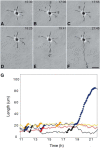The Development of Neuronal Polarity: A Retrospective View
- PMID: 29467146
- PMCID: PMC8130519
- DOI: 10.1523/JNEUROSCI.1372-16.2018
The Development of Neuronal Polarity: A Retrospective View
Abstract
In 1988, Carlos Dotti, Chris Sullivan, and I published a paper on the establishment of polarity by hippocampal neurons in culture, which continues to be frequently cited 30 years later (Dotti et al., 1988). By following individual neurons from the time of plating until they had formed well developed axonal and dendritic arbors, we identified the five stages of development that lead to the mature expression of neuronal polarity. We were surprised to find that, before axon formation, the cells pass through a multipolar phase, in which several, apparently identical short neurites undergo periods of extension and retraction. Then one of these neurites begins a period of prolonged growth, becoming the definitive axon; the remaining neurites subsequently become dendrites. This observation suggested that any of the initial neurites were capable of becoming axons, a hypothesis confirmed by later work. In this Progressions article, I will try to recall the circumstances that led to this work, recapture some of the challenges we faced in conducting these experiments, and consider why some of today's neuroscientists still find this paper relevant.
Copyright © 2018 the authors 0270-6474/18/381867-07$15.00/0.
Figures


References
MeSH terms
LinkOut - more resources
Full Text Sources
Other Literature Sources
